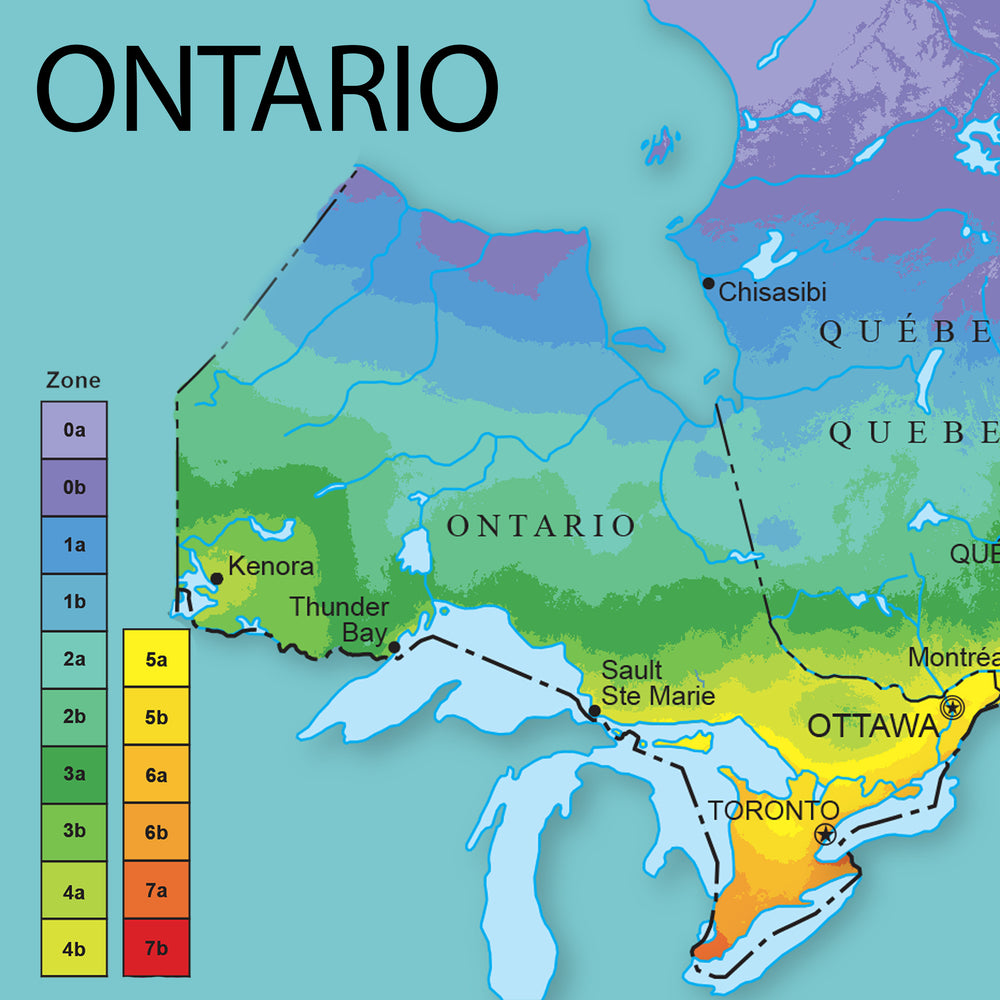Characteristics of Ontario Planting Region
The Ontario climate is classified as humid continental; however, the province has three distinct climatic regions.
1. Southern Ontario
The lower part of the province is affected by the nearby Great Lakes and generally experiences humid summers ranging from warm to hot and mild to cold winters. This region is also subject to thunderstorms, drought, and damaging winds.
 Southern Ontario | Image from Natural Resources Canada
Southern Ontario | Image from Natural Resources Canada
2. Central Ontario
This region is characterized by warm to somewhat hot summers and long, cold winters with heavy snowfall. As the snow thaws from winter, flooding of the rivers can be expected throughout the area.

3. Northern Ontario
The upper area of the province experiences a colder subarctic climate. The summers are generally mild, reaching cool to warm temperatures, while the winters are long and brutally cold with heavy snowfall. Additionally, the temperature tends to fluctuate dramatically across the region.

On average, the frost-free period of the region will start around the mid to end of May and finish around the end of October. However, it’s essential to learn the specific frost dates of your zone and region as the climate varies across the province.
Challenges of Growing in Ontario
Depending on the region of Ontario you’re located in, the challenges of growing will vary.
1. Southern Ontario
Extreme weather, such as droughts, high winds, and thunderstorms, poses difficulties for planting in this region. It’s crucial to monitor the weather changes and provide a protective covering for your garden to avoid any damage.
2. Central and Eastern Ontario
A shorter growing season, heavy snowfall, and spring flooding are the main challenges of planting in this area. Using raised garden beds and a protective covering are suggested to keep your plants out of harm’s way.
3. Northern Ontario
The subarctic climate, dramatic temperature fluctuations, and extended harsh winters are unfortunate barriers to gardening in this part of the province. Maximizing your growing time through indoor planting and protective coverings is necessary for your garden’s success.

The Benefits of Using a Greenhouse in Ontario
There are several benefits to using a greenhouse across the entire province of Ontario. They’ll offer protection from a variety of weather conditions and help extend growing seasons in each region. Learn more about the best greenhouses for the cold winters.
1. Extend your Growing Season
-
Without a Greenhouse:
The typical outdoor growing season in Ontario is anywhere between 3-4 months. However, early and late frosts are not uncommon, and many gardeners will struggle to grow warm-season vegetables without an element of indoor growing.
-
With a Greenhouse:
Gardeners across Ontario can double their planting season by using a greenhouse. As a result, you can expect extended growing seasons of 7-9 months, depending on your area, allowing you to enjoy fresh, homegrown vegetables well into the winter months.
So if you're searching for a greenhouse for sale in Ontario or backyard greenhouse kits Toronto, then reach out to our team at Planta Greenhouses today!
Learn more about specific growing dates for your area and the best vegetables to plant in each part of Ontario.



2. Grow a Wider Variety of Vegetables
-
Without a Greenhouse:
Planting options will differ across the province, and many areas of Ontario will find their options are limited for outdoor growing. However, some popular crops that are capable of growing across the region include:
- Arugula
- Spinach
- Kale
- Broccoli
- Lettuce
- Cabbage
- Cress
-
Radishes
-
With a Greenhouse:
The diverse climate of Ontario means vegetable options will vary across the province. In saying that, a greenhouse will allow you to grow a much wider variety of vegetables in every region. Although a majority of crops will thrive in a greenhouse in Ontario, some of the most popular plants include:
- Beans
- Beets
- Eggplant
- Sweet Corn
- Cucumbers
- Okra
- Squash
- Melons
- Asparagus
- Carrots
- Cauliflower
- Celery
- Swiss Chard
- Endive
- Head Lettuce
- Herbs
- Potatoes
- Tomatoes
- Cantaloupe
- Peppers
- Pumpkin
- Watermelon
- Zucchini
-
Collard Greens
Why Planta Greenhouses?
- Wind resistant up to 65 mph (learn more about how our greenhouses hold up in high-altitude climates).
- Withstands a snow load of up to 98 psf (480kg/square meter).
- Made with a heavy-duty galvanized steel frame.
- Polycarbonate panels provide 100% protection against UV rays.
- The Sungrow greenhouse is bell-shaped - allows the wind, snow, and hail to slide off the sides.
- Extendable (Sungrow, Sigma and Farmer models can be extended beyond 100ft)
- Made in Europe and are exclusively imported
-
Maintenance-free


